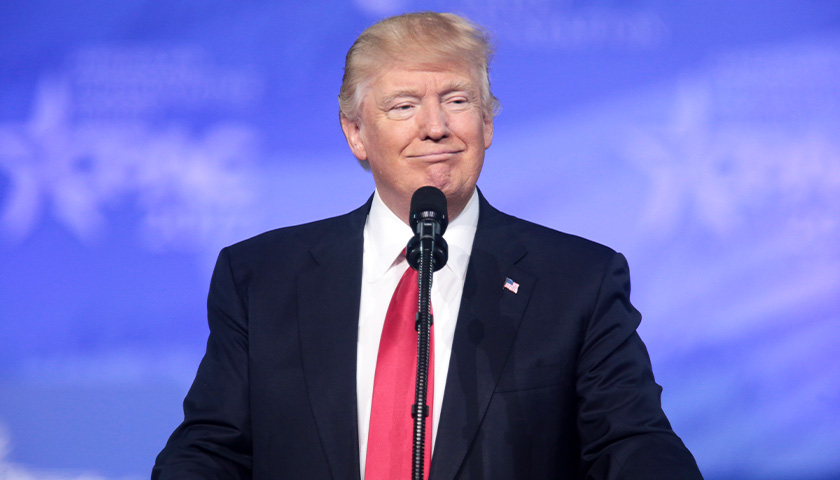by Robert Romano
After a disappointing outcome for the U.S. Congressional midterm elections – Democrats will retain the U.S. Senate without any net loss of seats, and Republicans poised to retake the U.S. House by a slim majority – political attention is already shifting to the race for 2024 and the White House against President Joe Biden, and to whether former President Donald Trump might run again for the nation’s highest office.
Midterms usually favor the opposition party, with a 90 percent likelihood of picking up seats in the U.S. House from 1906 to 2018, which did happen. The question now is how many seats and if it was definitively enough to win the race. As of this writing, Republicans have 212 seats to Democrats’ 205 seats in races that have been called, and Republicans have leads in nine races not yet called, just barely enough to get a majority.
Which matches the data: Republicans appear to have won the popular vote for the U.S. House, 52.1 million to 47.5 million, or 51.3 percent to 46.7 percent. While the margin of victory at the end of the day will be quite narrow and, barring an unforeseen surge in late races called in Democrats, will undoubtedly be disappointing to House Republican leaders, at the end of the day, a win’s a win.
On the Senate side, which heretofore had only afforded a 70 percent likelihood of picking up seats, elected Republican leaders are considering their own coattails were similarly not enough to secure Republican Senate wins where needed in New Hampshire, Pennsylvania, Nevada, Arizona and maybe Georgia, too.
The reason why these races were not GOP wins is twofold.
Low propensity Trump voters from 2020, who usually only vote in presidential elections, did not show up, or at least they did not show up enough in order for Republicans to win. In the meantime, thanks to early voting, enough low propensity Biden supporters were identified before the election to match GOP turnout in almost all of the key Senate races.
Georgia is a good example, where about 600,000 Trump supporters and 600,000 Biden supporters from 2020 both stayed home. That is normal in an off-year election and so usually the question comes down to who did a better job at activating those voters in the runup to the election. Clearly, Democrats did a better job in the swing states that mattered.
There’s still a chance that Herschel Walker could defeat Raphael Warnock for the Georgia Senate seat, which would be a pickup for the GOP, but it will come down to whether those low propensity Trump voters – who typically only vote in presidential elections – can be focused enough to turn out in the special election.
But do Republicans want Trump voters? How many candidates told Trump to stay away in 2022? That might have helped Republican governors keep their jobs, but what about down the ballot? Did that help?
In 2024, these problems for the GOP will be compounded as the U.S. enters the presidential reelection cycle, which unlike the midterms, usually favors the White House incumbent party. Sitting presidents who have stood for re-election have won about 70 percent of the time, although until the 1800s, state legislatures generally chose electors.
Since 1948, incumbent first-term presidents have a 67 percent reelection rate in their first terms. Harry Truman won in 1948, Dwight Eisenhower was re-elected in 1956, Lyndon Johnson won John Kennedy’s second term in 1964, Richard Nixon was re-elected in 1972, Gerald Ford was ousted in 1976, Jimmy Carter was ousted in 1980, Ronald Reagan was re-elected in 1984, George H.W. Bush was ousted in 1992, Bill Clinton was re-elected in 1996, George W. Bush was re-elected in 2004, Barack Obama was re-elected in 2012 and Trump was ousted in 2020.
So, depending on the circumstances, there’s only about a 1 in 3 chance that Biden could be ousted, and given Biden’s performance in the midterms plus the fact that he netted more than 80 million votes his first run, the odds seem lower than usual.
For that reason, presidential bids against a sitting president are usually about minimizing losses for the party, and if they get lucky, to pull off the upset.
Biden had coattails, or at least enough coattails to do what presidents are supposed to do in their first midterms: Rally the voters and minimize losses in Congress. Politically, that makes Biden at least as successful as Trump in his first and only midterm, who picked up two seats in the Senate for the GOP after losing the House.
That doesn’t mean Biden is unbeatable. Given the right combination of circumstances, sitting presidents can become vulnerable in their first terms of office. But it usually takes a recession. Just ask Herbert Hoover, Jimmy Carter, George H.W. Bush and Donald Trump. And thanks to the inflation, the continued global supply chain crisis and Russia’s invasion of Ukraine, Biden appears to have a recession, although just how bad it will be from an unemployment standpoint remains to be seen.
But to take advantage of that opportunity, Republicans will need to be united in 2024.
Usually, what happens in presidential reelection cycles, especially when the incumbent party has only held the White House for one term as opposed to two or three terms, is the President runs relatively unopposed in the primary, keeping his base united, while the opposition party will have a competitive primary. Generally, the more beat up the opposition party’s candidate gets in the primary under those circumstances, the less likely he or she is to win the general election.
The odds of an upset increase when Presidents are opposed in their primaries. Lyndon Johnson withdrew from the 1968 after he barely won the New Hampshire primary. Jimmy Carter went on to be defeated by Ronald Reagan in the general election after a competitive primary with Ted Kennedy in 1980. George H.W. Bush was defeated in the general election by Bill Clinton after a competitive primary with Pat Buchanan in 1992. All three years were wins for the opposition party.
In 2020, Trump ran relatively unopposed and easily secured his party’s nomination. So, despite the Covid recession – where by April 2020, there were 25 million jobs lost – Trump managed to get an economic program in place to withstand the pandemic lockdowns, keep his base together, pick up 14 seats in the U.S. House elections and barely lost the presidential contest by a scant 43,000 votes in Georgia, Arizona and Wisconsin.
That makes the question of whether Biden runs or not actually more important than if Trump runs. If Democrats have a competitive primary because Biden stands aside and does not run, the odds of an upset rise again. Dwight Eisenhower and Richard Nixon were both elected after sitting Democratic presidents Harry Truman and Lyndon Johnson opted not to run again.
Whereas the novelty of a former president running for reelection is much more rare. It happens, just not too often: Martin Van Buren in 1844 and 1848, Millard Fillmore in 1856, Ulysses S. Grant in 1880, Grover Cleveland in 1892 and Theodore Roosevelt in 1912.
Of those, only Cleveland was able to get reelected, and the reason is simple: He had the Democratic Party’s nomination in 1892. Whereas every other former president to run lost their former party’s nomination. 1912 is an interesting case where Theodore Roosevelt actually won the primaries but lost the nomination at the GOP convention to the sitting then-President William Taft. 1912 also stands as the only test of a former president in primaries.
Like Roosevelt, Trump is still very popular among Republicans, who will decide the nomination, garnering 81 percent favorability among Republicans, including 50 percent very favorable, in the last Economist-YouGov poll taken prior to the 2022 midterms.
78 percent of Republicans in a Quinnipiac survey taken in October say they want Trump to run for president again.
That will make him very hard to beat.
But Trump, should he run, should still be tested by other Republican candidates. It is unclear if Republican voters truly want him to be president again. Fortunately, in the modern presidential primary process, there’s a sure-fire way to find out.
Ron DeSantis easily won reelection in Florida in 2022 and showed he had coattails of his own, netting four seats in the U.S. House, without which a Republican majority would be impossible. Other successful governors like Kim Reynolds in Iowa and Brian Kemp in Georgia, who also picked up a U.S. House seat apiece in their reelection bids, have stories to tell as well. And, if they wish to test Trump’s viability in 2024, they should run.
And Trump might not be the problem. Nominally pro-Trump candidates like Lee Zeldin in New York (who voted in favor Trump’s election challenges on Jan. 6, 2021 and against his impeachments) and DeSantis in Florida, who was elected the first time on Trump’s coattails in 2018, did very well in 2022, and picked up the House seats that will make the Republican majority in 2023.
In truth, the biggest problem Republicans had in 2022 was getting enough low propensity Trump voters to the polls to make a difference in key statewide and House races. In Ohio and Wisconsin, in the Senate, and maybe Arizona, the latter of which has netted the GOP two House seats so far thanks to Kari Lake’s strong run for governor there, it was enough.
In 2024, they will have the same problem of activating his base – that is, unless Trump runs. But the worst case scenario for the GOP would actually be a repeat of 1912, where, like Theodore Roosevelt, Trump runs and wins the primaries but then is denied the nomination at the national convention.
One thing is for certain, if Trump voters are disenfranchised in the 2024 contest for the GOP nomination, they will almost certainly stay home and Biden will win in a landslide. That is the real Trump card in 2024.
– – –
Robert Romano is the Vice President of Public Policy at Americans for Limited Government Foundation.
Photo “Donald Trump” by Gage Skidmore. CC BY-SA 2.0.





